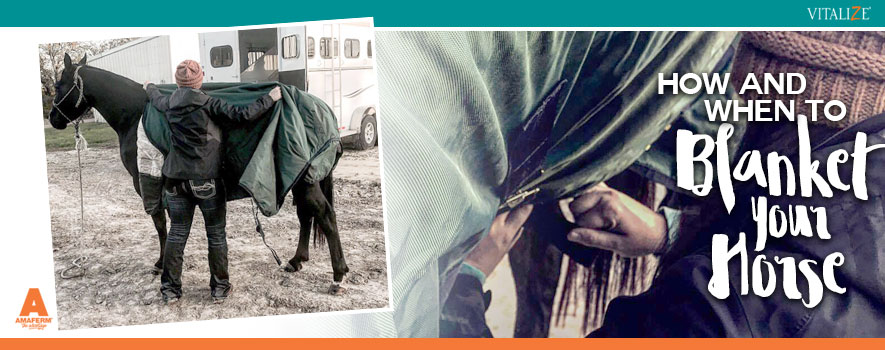
While you may be shivering in the barn aisle once the temperature drops below 50 degrees, horses are much more well adapted to the cold weather. As the days grow shorter, the horse responds to the diminishing sunlight by growing long hair all over the body. When it is very cold, these hairs stand up to keep cold air further away from their skin. They also have several other adaptations that allow them to cope with cold weather and avoid frostbite. These include a muzzle that is richly supplied with circulating blood, feet that are engineered for subzero temperatures and snow, blood vessels in the skin that easily constrict to minimize heat loss, and large blocks of muscles that allow them to shiver more readily and efficiently than a human.
Despite these mechanisms that help horses combat cold weather, it is often necessary to use rugs or blankets to keep horses warm. Whether your horse needs a blanket or not depends on his hair coat, age, and body condition as well as the temperature, moisture, and wind outside. There are generally three weights of blankets available for horse owners to purchase. The light blanket has 0 to 100 grams of fill, the medium blanket has 150 to 250 grams of fill, and the heavy blanket has 300 to 400 grams of fill.
In the winter, many show horses or horses that are worked regularly are body clipped in order to avoid the excessive sweating that leaves the horse susceptible to becoming chilled and getting sick. Generally, horses that are body clipped in the winter will need a light blanket when the temperature drops below 50 degrees, a medium blanket below 40 degrees, and a heavy blanket below 30 degrees. Horses that are not body clipped will need a light blanket when the temperature drop below 40 degrees, a medium blanket below 30 degrees, and a heavy blanket below 20 degrees. Keep in mind that this is only a guide. As a horse’s age increases or body condition decreases, they will likely need a blanket at slightly warmer temperatures. Also, if your horse lives outside, you will also want to take wind chill and precipitation into account when trying to decide when to blanket or which blanket to use. The insulating ability of a horse’s hair coat is lost when it becomes wet or muddy. Therefore, it is important to provide the horse shelter where they can stay dry or use a waterproof blanket when precipitation is forecasted.
Getting a blanket that fits correctly is also vital. Blankets that are too small may rip or rub your horse causing sores on the shoulders, withers or hips. Blankets that are too large can slide to one side of the horse and become tangled in the horse’s legs, which is not only uncomfortable and dangerous for the horse, but also causes damage to the blanket. In order to get a correctly fitting blanket, stand your horse squarely and place a measuring tape in the center of the chest at the base of the neck. Then, extend the measuring tape across the widest part of the shoulder and continue to extend it along the horse’s side and across the point of the buttocks, which is the hindmost portion of the buttocks and approximately 10 to 12 inches below the point where the tail meets the body. This measurement (in inches) is equivalent to the blanket size the horse requires. Typically, an average sized horse ranges from 76 to 82 inches in size.
So when the leaves start changing, the temperatures start dropping and there’s even a little frost on the pumpkin, remember there’s no easy answer when it comes to whether or not you should blanket your horse. Rather you have to determine what is best for each horse you care for. Prior to making your blanketing decision look at your horse’s individual needs, housing situation and local climate conditions. By treating each horse as an individual you will ensure they stay happy, healthy and comfortable during the cold winter months.

